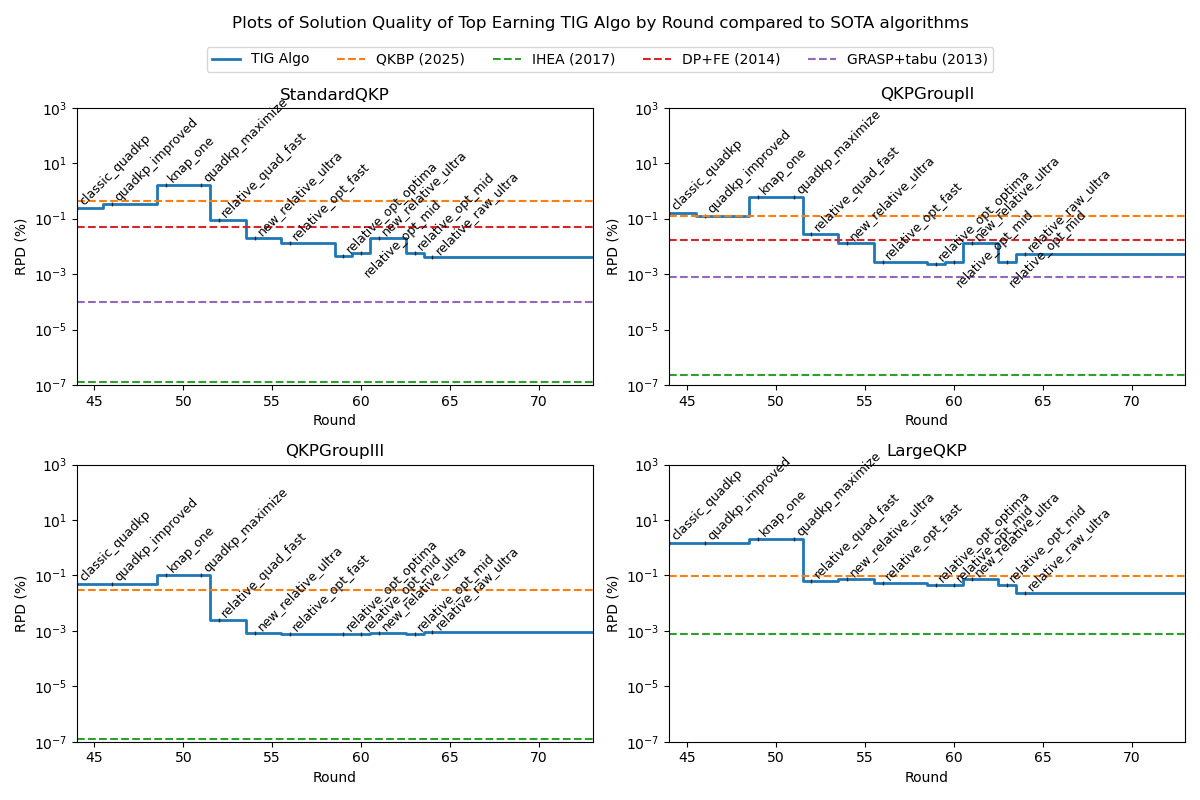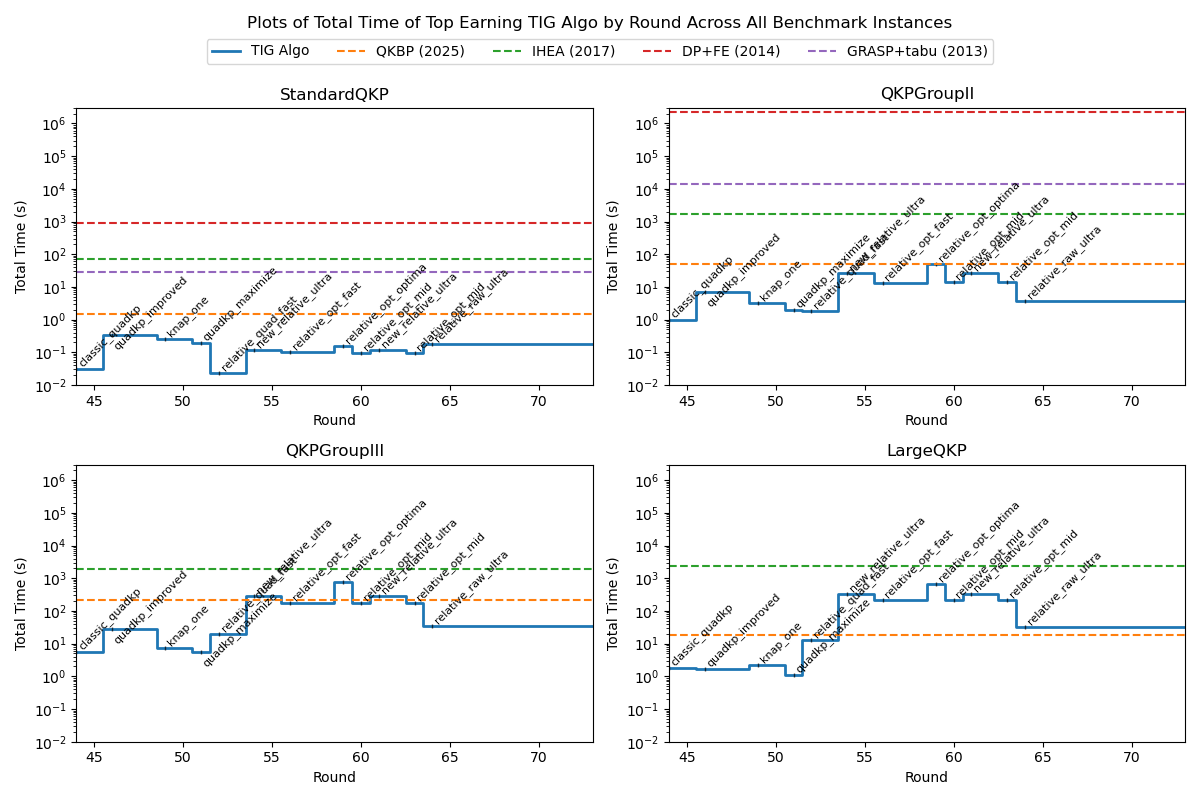
The Innovation Game (TIG), a protocol designed to accelerate algorithmic progress through open, competitive challenges, has achieved validation of its core underlying thesis:
TIG’s foundational incentive-driven model has produced a new algorithm for the Quadratic Knapsack Problem (QKP)—a notoriously difficult combinatorial optimization task with real-world applications in logistics, finance, gene cluster analysis, and network planning—that outperforms recent state-of-the-art (SOTA) methods developed by leading academic researchers.
Let’s first review what TIG is, for those unfamiliar, and then dive straight into this milestone news.
A Primer On The Innovation Game
TIG is a decentralized protocol designed to accelerate algorithmic progress by turning algorithm development into an open, incentive-driven competition.
At its core, TIG transforms proof-of-work into a global engine for open, autonomous innovation, rewarding contributors who advance algorithms in complex scientific and computational research domains.
Participants can either submit new algorithms or utilize benchmarking infrastructure to identify the best-performing algorithms. By combining these roles within a transparent and open ecosystem, TIG coordinates global intelligence in pursuit of breakthroughs.
Unlike traditional research institutions or corporate labs, TIG is fully open and meritocratic; anyone in the world can contribute and be rewarded. The protocol’s synthetic proof-of-work challenges are tied directly to real-world needs in areas like artificial intelligence, cryptography, biomedicine, and climate science.
The vision: build a global innovation engine that democratizes access to cutting-edge algorithms and applies them toward humanity’s most important problems, at a pace that centralized systems cannot match.
A Benchmark Problem, Reimagined
The Quadratic Knapsack Problem is widely recognized for its computational complexity. As an extension of the classical Knapsack Problem, it incorporates not only the value of individual items but also the interactions between pairs, significantly increasing the challenge of finding optimal solutions. This complexity makes QKP an ideal benchmark for stress-testing algorithmic efficiency, and for TIG, a proving ground for its incentive-driven innovation model.
In Round 44 of the protocol, TIG evolved its initial Knapsack Challenge into the more complex Quadratic Knapsack Challenge. What followed was a rapid cycle of iteration, where each new submission built upon the last. Thanks to the protocol’s open visibility and incentive design, participants were able to learn from, refine, and compete with prior methods in real time.
Over time, this resulted in a measurable and dramatic improvement in both runtime and solution quality. The Relative Percentage Deviation (RPD) from the optimal solution dropped significantly across benchmark instances, while the time required to achieve these results decreased by orders of magnitude.
A Validated Model for Algorithmic Innovation
TIG’s top-earning algorithm now competes directly with leading SOTA approaches such as GRASP+Tabu (Yang et al., 2013) and IHEA (Chen & Hao, 2017), while outperforming others like DP+FE (Fomeni & Letchford, 2014) and QKBP (Hochbaum et al., 2025) on most benchmarks.
** For a detailed breakdown of each method, see the appendix at the end of this article.
Its standout trait is runtime efficiency: in several cases, it achieves comparable or better solution quality with substantially lower computational cost. This performance edge is especially critical for real-world applications, where processing speed and memory usage directly impact viability.
Crucially, these results were not the product of one breakthrough submission, but the emergent outcome of many iterations.
TIG’s model incentivizes both groundbreaking advances and incremental improvements in efficiency, rewarding those who optimize memory usage, reduce runtime, or build modular enhancements on prior solutions. The success of the QKP challenge validates this approach as a systematic driver of algorithmic progress.
As the TIG team notes, this marks a turning point:
“TIG’s model for open innovation is no longer theoretical; it is a proven engine for algorithmic advancement.”
The below figures illustrate the steady improvement of solution quality and algorithm efficiency across TIG rounds, showing how open innovation and collaboration drive state-of-the-art performance.
Refer to the TIG blog for more details.


What’s Next
With the QKP milestone complete, TIG is preparing to expand its challenge model to new domains. Future challenges will focus on high-impact fields such as artificial intelligence, scientific research, and complex optimization problems in industry. The goal is to generate not only algorithms that are better than current SOTA algorithms but also licensable, production-grade solutions that solve real problems across sectors.
By turning algorithm development into a competitive and collaborative process, TIG offers a new paradigm for accelerating computational innovation—one that rewards both performance and progress.
To learn more, visit: https://tig.foundation/
Appendix: Referenced Quadratic Knapsack Methods